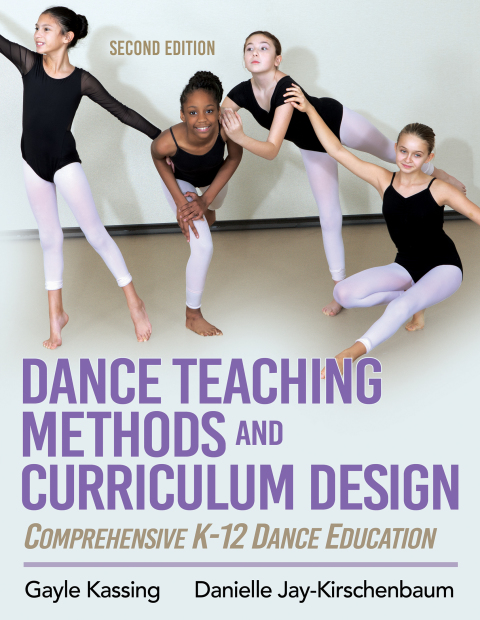Description
Efnisyfirlit
- Title Page
- Copyright
- Epigraphs
- Contents
- Preface
- Acknowledgments
- Student and Instructor Resources in HKPropel
- Part I: Teaching Dance
- 1. Envisioning Dance Education
- Defining Dance and Dance Education
- Distinguishing Between Dancers and Dance Educators
- Teaching Dance in the 21st Century
- Relating Standards for Dance to Dance Education
- Understanding the Teaching and Learning Process Model in Dance
- Summary
- Application Activities
- 2. Teaching Dance From a Holistic Perspective
- Comprehensive Dance Knowledge Model
- Supportive Knowledge
- Dance Training, Conditioning, and Wellness
- Technique and Choreography
- Education Theories for Teaching Dance
- Artistic Development
- Summary
- Application Activities
- 3. Observing and Analyzing the Teaching and Learning Situation
- Understanding Observation Techniques in the Dance Class
- Applying Kinesiology Observation to Dance
- Developing Observation Skills
- Summary
- Application Activities
- 4. Guiding Students in Learning Dance
- Three Styles of Student Learning
- Movement–Language Connection in Dance
- Constructing the Dance Class
- Summary
- Application Activities
- 5. Understanding Dance Teaching Methods
- Choosing a Presentational Method
- Teaching Strategies for the Dance Class
- Teaching Methods for Specific Dance Forms
- Understanding Music and Accompaniment in the Dance Class
- Summary
- Application Activities
- 6. Organizing and Managing the Dance Class
- Creating a Positive Learning Atmosphere
- Managing the Dance Classroom
- Dealing With Student Behaviors in the Dance Classroom
- Developing a Philosophy of Teaching Dance
- Summary
- Application Activities
- 7. Analyzing the Learner and the Learning Environment
- Understanding Characteristics of Different Learners
- Developing Social and Emotional Behaviors in the Dance Class
- Understanding Dance and the Dance Teacher in K-12 Education
- Characterizing the Community
- Identifying Values in the Community
- Summary
- Application Activities
- 8. Categorizing Dance Forms and Their Artistic Demands
- Gathering Content Information to Teach Dance
- Identifying Characteristics of Dance Forms
- Understanding the Format of the Dance Class
- Dance and Other Disciplines
- Utilizing Principles of the Dance Form
- Teaching Artistic Development
- Summary
- Application Activities
- Part II: Planning Lessons
- 9. Developing the Lesson Plan
- Setting Up Effective Dance Learning Experiences
- Describing the Lesson Plan
- Relating Objectives or Outcomes to a Learning Taxonomy
- Summary
- Application Activities
- 10. Selecting Appropriate Assessment Strategies for Dance
- Using Assessment Techniques in the Dance Class
- Grading Students’ Work
- Summary
- Application Activities
- 11. Writing and Delivering the Lesson Plan
- Writing the Lesson Plan
- Teaching the Lesson
- Exploring Other Options
- Summary
- Application Activities
- Part III: Creating Curriculum Plans
- 12. Creating a Curriculum
- Surveying Options for Discipline-Based Dance Curriculum Models
- Starting the Instructional Design Process
- Writing a Dance Curriculum
- Formally Evaluating Dance Curricula and Programs
- Summary
- Application Activities
- 13. Sample Units for Dance Forms
- Overview of Dance Forms
- Teaching Overview
- Content Overview
- Unit 13.1 Creative Movement and Creative Dance
- Unit 13.2 Folk Dance
- Unit 13.3 Cultural Dances of Africa
- Unit 13.4 Mexican Folkloric Dance
- Unit 13.5 Square Dance
- Unit 13.6 Contra Dance
- Unit 13.7 Line Dance
- Unit 13.8 Social Dance
- Unit 13.9 Ballet
- Unit 13.10 Modern Dance
- Unit 13.11 Jazz Dance
- Unit 13.12 Tap Dance
- Unit 13.13 Hip-Hop Dance
- Unit 13.14 Dance Fitness
- 14. Culminating Curriculum Portfolio
- Depicting the Teaching Environment
- Describing the Learner
- Selecting Dance Content for Each Unit Plan
- Devising Learning Experiences for the Dance Form
- Writing the Lesson Plans
- Appendix
- Glossary
- References and Resources
- Index
- About the Authors







Reviews
There are no reviews yet.